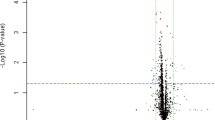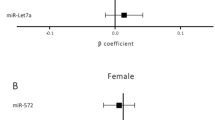Abstract
Recent trials with inhibition of the renin–angiotensin–aldosterone system (RAAS) in patients with established atherosclerosis have been equivocal. MicroRNAs (miRs) are known to affect multiple pathways relevant to atherosclerosis, including RAAS. We postulated that the use of a direct renin antagonist would result in differential regulation of miRs. We examined monocyte miR expression before and after treatment with renin antagonist, Aliskiren, in patients with established cardiovascular disease as part of a prospective, single-center, randomized, double-blind and placebo-controlled clinical trial (NCT01417104). After screening, patients (mean age 62±3 years) were randomized to placebo or Aliskiren. Three-dimensional dark-blood magnetic resonance imaging assessment of atherosclerosis in the thoracic and abdominal aorta was conducted at baseline and at study completion (19–36 weeks). MiR expression arrays were performed on RNA from peripheral blood mononuclear cells collected at baseline and 12 weeks following randomization to placebo or Aliskiren and showed that hsa-miR-106b-5p, 27a-3p and 18b-5p were significantly downregulated with Aliskiren. Baseline expression of these miRs positively correlated with normalized total wall volume in subjects taking Aliskiren (miR-106b, R=0.62; miR-27a, R=0.63; miR-18b, R=0.77; P<0.05). Hsa-miR-106b-5p, 27a-3p and 18b-5p may represent pathway-specific adaptations to renin inhibition relevant to atherosclerosis.
This is a preview of subscription content, access via your institution
Access options
Subscribe to this journal
Receive 12 digital issues and online access to articles
$119.00 per year
only $9.92 per issue
Buy this article
- Purchase on Springer Link
- Instant access to full article PDF
Prices may be subject to local taxes which are calculated during checkout





Similar content being viewed by others
References
Dahlof B, Devereux RB, Kjeldsen SE, Julius S, Beevers G, de Faire U et al. Cardiovascular morbidity and mortality in the Losartan Intervention For Endpoint reduction in hypertension study (LIFE): a randomised trial against atenolol. Lancet 2002; 359 (9311): 995–1003.
Yusuf S, Sleight P, Pogue J, Bosch J, Davies R, Dagenais G . Effects of an angiotensin-converting-enzyme inhibitor, ramipril, on cardiovascular events in high-risk patients. The Heart Outcomes Prevention Evaluation Study Investigators. N Engl J Med 2000; 342 (3): 145–153.
Dzau VJ . Theodore Cooper Lecture: Tissue angiotensin and pathobiology of vascular disease: a unifying hypothesis. Hypertension 2001; 37 (4): 1047–1052.
Nguyen Dinh Cat A, Touyz RM . A new look at the renin-angiotensin system—focusing on the vascular system. Peptides 2011; 32 (10): 2141–2150.
Azizi M, Webb R, Nussberger J, Hollenberg NK . Renin inhibition with aliskiren: where are we now, and where are we going? J Hypertens 2006; 24 (2): 243–256.
Fisher ND, Meagher EA . Renin inhibitors. J Clin Hypertens 2011; 13 (9): 662–666.
Imanishi T, Tsujioka H, Ikejima H, Kuroi A, Takarada S, Kitabata H et al. Renin inhibitor aliskiren improves impaired nitric oxide bioavailability and protects against atherosclerotic changes. Hypertension 2008; 52 (3): 563–572.
Lu H, Rateri DL, Feldman DL, Charnigo Jr RJ, Fukamizu A, Ishida J et al. Renin inhibition reduces hypercholesterolemia-induced atherosclerosis in mice. J Clin Invest 2008; 118 (3): 984–993.
Kuhnast S, van der Hoorn JW, van den Hoek AM, Havekes LM, Liau G, Jukema JW et al. Aliskiren inhibits atherosclerosis development and improves plaque stability in APOE*3Leiden.CETP transgenic mice with or without treatment with atorvastatin. J Hypertens 2012; 30 (1): 107–116.
Parving HH, Brenner BM, McMurray JJ, de Zeeuw D, Haffner SM, Solomon SD et al. Baseline characteristics in the Aliskiren Trial in Type 2 Diabetes Using Cardio-Renal Endpoints (ALTITUDE). J Renin Angiotensin Aldosterone Syst 2012; 13 (3): 387–393.
Mihai G, Varghese J, Kampfrath T, Gushchina L, Hafer L, Deiuliis J et al. Aliskiren effect on plaque progression in established atherosclerosis using high resolution 3D MRI (ALPINE): a double-blind placebo-controlled trial. J Am Heart Assoc 2013; 2 (3): e004879.
Martin MM, Lee EJ, Buckenberger JA, Schmittgen TD, Elton TS . MicroRNA-155 regulates human angiotensin II type 1 receptor expression in fibroblasts. J Biol Chem 2006; 281 (27): 18277–18284.
Nossent AY, Hansen JL, Doggen C, Quax PH, Sheikh SP, Rosendaal FR . SNPs in microRNA binding sites in 3'-UTRs of RAAS genes influence arterial blood pressure and risk of myocardial infarction. Am J Hypertens 2011; 24 (9): 999–1006.
Sober S, Laan M, Annilo T . MicroRNAs miR-124 and miR-135a are potential regulators of the mineralocorticoid receptor gene (NR3C2) expression. Biochem Biophys Res Commun 2010; 391 (1): 727–732.
Wang K, Long B, Zhou J, Li PF . miR-9 and NFATc3 regulate myocardin in cardiac hypertrophy. J Biol Chem 2010; 285 (16): 11903–11912.
Marques FZ, Campain AE, Tomaszewski M, Zukowska-Szczechowska E, Yang YH, Charchar FJ et al. Gene expression profiling reveals renin mRNA overexpression in human hypertensive kidneys and a role for microRNAs. Hypertension 2011; 58 (6): 1093–1098.
Mihai G, Chung YC, Kariisa M, Raman SV, Simonetti OP, Rajagopalan S . Initial feasibility of a multi-station high resolution three-dimensional dark blood angiography protocol for the assessment of peripheral arterial disease. J Magn Reson Imaging 2009; 30 (4): 785–793.
Mihai G, Chung YC, Merchant A, Simonetti OP, Rajagopalan S . T1-weighted-SPACE dark blood whole body magnetic resonance angiography (DB-WBMRA): initial experience. J Magn Reson Imaging 2010; 31 (2): 502–509.
Geiss GK, Bumgarner RE, Birditt B, Dahl T, Dowidar N, Dunaway DL et al. Direct multiplexed measurement of gene expression with color-coded probe pairs. Nat Biotechnol 2008; 26 (3): 317–325.
Friedman RC, Farh KK, Burge CB, Bartel DP . Most mammalian mRNAs are conserved targets of microRNAs. Genome Res 2009; 19 (1): 92–105.
Bonauer A, Boon RA, Dimmeler S . Vascular microRNAs. Curr Drug Targets 2010; 11 (8): 943–949.
Urbich C, Kuehbacher A, Dimmeler S . Role of microRNAs in vascular diseases, inflammation, and angiogenesis. Cardiovasc Res 2008; 79 (4): 581–588.
Liu T, Shen D, Xing S, Chen J, Yu Z, Wang J et al. Attenuation of exogenous angiotensin II stress-induced damage and apoptosis in human vascular endothelial cells via microRNA-155 expression. Int J Mol Med 2013; 31 (1): 188–196.
Nissen SE, Tardif JC, Nicholls SJ, Revkin JH, Shear CL, Duggan WT et al. Effect of torcetrapib on the progression of coronary atherosclerosis. N Engl J Med 2007; 356 (13): 1304–1316.
Nissen SE, Nicholls SJ, Wolski K, Nesto R, Kupfer S, Perez A et al. Comparison of pioglitazone vs glimepiride on progression of coronary atherosclerosis in patients with type 2 diabetes: the PERISCOPE randomized controlled trial. JAMA 2008; 299 (13): 1561–1573.
Cai K, Wang Y, Bao X . MiR-106b promotes cell proliferation via targeting RB in laryngeal carcinoma. J Exp Clin Cancer Res 2011; 30: 73.
Liu Z, Yang D, Xie P, Ren G, Sun G, Zeng X et al. MiR-106b and MiR-15b modulate apoptosis and angiogenesis in myocardial infarction. Cell Physiol Biochem 2012; 29 (5–6): 851–862.
Petrocca F, Vecchione A, Croce CM . Emerging role of miR-106b-25/miR-17-92 clusters in the control of transforming growth factor beta signaling. Cancer Res 2008; 68 (20): 8191–8194.
Smith AL, Iwanaga R, Drasin DJ, Micalizzi DS, Vartuli RL, Tan AC et al. The miR-106b-25 cluster targets Smad7, activates TGF-beta signaling, and induces EMT and tumor initiating cell characteristics downstream of Six1 in human breast cancer. Oncogene 2012; 31 (50): 5162–5171.
Singh NN, Ramji DP . The role of transforming growth factor-beta in atherosclerosis. Cytokine Growth Factor Rev 2006; 17 (6): 487–499.
Graff JW, Dickson AM, Clay G, McCaffrey AP, Wilson ME . Identifying functional microRNAs in macrophages with polarized phenotypes. J Biol Chem 2012; 287 (26): 21816–21825.
Karolina DS, Tavintharan S, Armugam A, Sepramaniam S, Pek SL, Wong MT et al. Circulating miRNA profiles in patients with metabolic syndrome. J Clin Endocrinol Metab 2012; 97 (12): E2271–E2276.
Acknowledgements
This study was funded by Novartis Pharmaceuticals.
Author information
Authors and Affiliations
Corresponding author
Ethics declarations
Competing interests
The authors declare no conflict of interest.
Additional information
Supplementary Information accompanies this paper on the Journal of Human Hypertension website
Supplementary information
Rights and permissions
About this article
Cite this article
Deiuliis, J., Mihai, G., Zhang, J. et al. Renin-sensitive microRNAs correlate with atherosclerosis plaque progression. J Hum Hypertens 28, 251–258 (2014). https://doi.org/10.1038/jhh.2013.97
Received:
Revised:
Accepted:
Published:
Issue Date:
DOI: https://doi.org/10.1038/jhh.2013.97
Keywords
This article is cited by
-
Epigenetics and the role of nutraceuticals in health and disease
Environmental Science and Pollution Research (2023)
-
The link among microbiota, epigenetics, and disease development
Environmental Science and Pollution Research (2021)
-
Identification of key microRNAs in the carotid arteries of ApoE−/− mice exposed to disturbed flow
Hereditas (2019)



